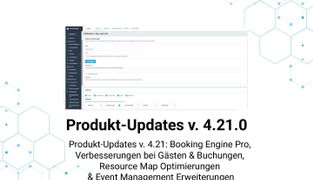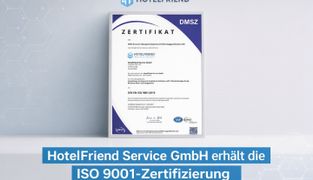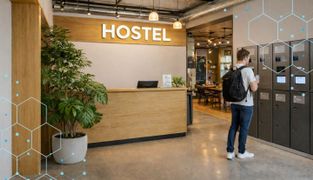While some hoteliers choose to transition from an on-premise PMS to a cloud-based system for flexibility and innovation, others do this because their software provider requires it.
If you find yourself in either situation, this article is here to help. We'll explore why moving to the cloud is becoming increasingly important in the hotel industry and offer practical advice on how to implement this shift smoothly.
Let’s talk about “on-premise vs cloud”
The hospitality property management software market is growing rapidly, bringing a wider variety of options for hoteliers. In 2023, this market was valued at USD 7.15 billion.
By 2030, it is expected to double to USD 14.71 billion, growing at an exciting annual rate of 10.77%. This means that even more Property Management System solutions will be available in the near future.
With so many options emerging, it's important to understand the difference between the two main types of PMS, which are on-premise and cloud-based systems.
What is on-premise hotel software?
On-premise PMS solutions have been a long-standing choice for many businesses, particularly those that prefer having direct control over their software and data.
They require local IT infrastructure, including servers and storage, and need to be installed locally on your company’s hardware. The following setup usually involves great upfront costs for hardware and software licenses.
With on-premise solutions, your business is responsible for maintaining the equipment and software updates, which can demand dedicated IT personnel and resources. Handling security measures, backups, and data recovery processes is usually the responsibility of your IT team.
What is cloud-based hotel software?
The cloud systems work through web-based platforms, meaning all data and software resources are hosted offsite by a service provider and accessed via the Internet. This means no need for significant local IT infrastructure.
They also typically follow a subscription model, allowing businesses to pay for services on a monthly or annual basis. Designed to be scalable, they easily accommodate growth and expansion without requiring major investments.
A quick comparison of on-premise and cloud PMS
To better understand the contrasting elements of these two solutions, we've made a table that provides an at-a-glance comparison of their key features.
|
Feature |
On-premise |
Cloud-based |
|
Installation |
Requires local hardware and setup |
Hosted online, accessed via the internet |
|
Cost Structure |
High upfront costs for hardware and licenses |
Subscription-based, spread over time |
|
Accessibility |
Restricted to on-site access |
Accessible from anywhere with an internet connection |
|
Scalability |
Limited flexibility; requires additional hardware for expansion |
Easily scalable to accommodate growth without major expense or downtime |
|
Maintenance and Updates |
Managed internally; requires dedicated IT resources |
Managed by provider; includes regular updates and security patches |
|
Security |
Responsibility of the internal team |
Provider ensures advanced security measures |
|
Integration |
Limited to specific software and systems |
Typically integrates easily with various systems and tools |
|
Data Backup and Recovery |
Managed in-house, requiring regular attention |
Automated by provider with built-in backup systems |
|
Compliance |
Managed internally, requires ongoing effort |
Provider ensures compliance with the latest regulations |
|
Support |
Requires in-house IT support |
Provider usually offers support and resources |
In a nutshell, with local systems, the business is responsible for all maintenance, updates, and security. Cloud solutions shift this responsibility to the provider, and offer automatic updates, regular maintenance, and support included in the service package.
Why are businesses switching to the cloud?
Driven by their digital transformation plans or pressing needs, hospitality businesses are discovering that cloud-based systems come with compelling benefits. Here are some reasons why the cloud is becoming a preferred choice for many hoteliers.
● Allows you and your staff to work from anywhere
One of the biggest advantages of cloud-based systems is the ability to work from virtually any location with internet access. This flexibility is invaluable, particularly in today's environment, where remote work has become almost a new normal.
Cloud solutions allow teams to access essential tools and information, fostering effective collaboration without confining them to a physical office space.
● Adapts to business growth
Unlike on-premise systems, cloud solutions can expand effortlessly as your needs increase. Whether you're opening new locations or planning to offer new services for guests, cloud platforms can accommodate these changes with minimal disruption and without additional investment on top.
● Makes your monthly expenses more predictable
Cloud PMS typically offers a pay-as-you-grow pricing model. This approach means you pay for only what you use, which helps in maintaining predictable monthly expenses. This definitely makes cloud options more financially attractive.
● Satisfies regulatory requirements
Compliance with industry regulations is a priority for businesses. Cloud providers handle system updates to meet the latest legal standards, relieving companies of the burden of managing these complexities internally.
Making the most of a mandatory switch
In some cases, the decision to switch from an on-premise property management system to a cloud-based alternative isn't a voluntary one.
When your existing provider mandates a shift to their cloud services, it can be unsettling, leaving you to ponder whether it's the right fit for your business. However, this unexpected change can also be an opportunity to evaluate all your options and potentially find a solution better suited to your needs.

Let’s see what to do if you find yourself in this scenario:
1. Assess your current situation
Start by evaluating the impact of remaining with your existing provider if they insist on a move to their cloud services. Carefully examine the terms, costs, and benefits of their proposed solution to see if it aligns with your operational goals and financial constraints. This will help you make an informed decision about whether to stay or explore other options.
2. Consider alternative solutions
If parts of the provider's cloud offering don't meet your requirements, it might be time to explore other vendors.
3. Review other cloud providers
Investigate other cloud PMS providers that cater explicitly to the needs of hotels. Compare their features, pricing, and scalability to ensure they align with your business objectives. This comparison can reveal options that might be more flexible or cost-effective.
4. Evaluate functionality and support
Beyond technical capabilities, assess the support and training options available from potential new providers. Reliable, accessible support can play a key role during the transition and ongoing operations, ensuring your team can adapt smoothly to the new system.
The forced transition can bring along many challenges, but it opens the door to potentially gaining a more aligned system that could improve your operations. Embrace this change with an open mind as a contribution to your business growth.
Overcoming challenges of switching to a new system
Instead of viewing this as a burden, consider it an opportunity to enhance operations. Proper preparation will be key to a smooth changeover, with minimum disruptions and maximum traction from your new system.
Here, we'll outline the main steps you can take to facilitate this transition effectively (which we usually do in HotelFriend). For a more comprehensive guide, be sure to explore our in-depth article, "A Guide To Switching PMS Software: 7-Step Migration Plan For Hospitality Professionals."
Step 1: Prepare for the transition
Planning is everything. Outlining a well-structured migration roadmap will be the first step to a successful transition from on-premise to cloud PMS.
● Develop a detailed plan that outlines each step of the transition, from initial setup to final implementation. Identify key milestones and allocate responsibilities to ensure all aspects of the migration are covered.
● Establish a sensible timeframe that minimizes downtime and disruption. Factor in time for data migration, testing, and staff training to ensure a comprehensive and smooth transition.
● Involve IT personnel, department heads, and end-users from the start. Their insights will help align the transition with your business goals and iron out potential issues early.
Step 2: Going through the transition process
At the heart of switching to a new PMS is data migration. How complicated this will be depends on several factors.
For instance, switching from a custom-built system to a pre-packaged SaaS solution can be particularly challenging. Even if you're simply upgrading to the cloud version offered by your current vendor, careful planning is essential to address any custom features of your existing setup.
Choose your data migration approach
You have two main options when it comes to migrating your PMS data:
● Transfer all historical data: This approach ensures continuity by keeping all guest and revenue details intact. However, it's a more time-consuming process, potentially leading to longer downtime, which can be tricky for hotels that operate around the clock. If your chain has standardized certain systems, the complexity may increase further.
● Start fresh without historical data: Opting to leave historical data behind can speed up the migration and reduce costs. It also allows you to standardize new systems more easily. The trade-off is that you won't have access to past data in the cloud, necessitating retention of the old on-premises application for historical reference.
Other things to keep in mind
● Start with a small number of users to identify potential issues. Use this feedback to make necessary adjustments before a full rollout.
● Work with your cloud provider to establish a clear migration strategy. Use any available migration tools or services to simplify this process.
● Implement comprehensive training programs that cater to various user needs. Creating an open environment where feedback is welcomed will help ease the adaptation process.
Step 3: Settling into the Cloud Environment
Once migration is complete, you need to fully integrate the new system into your daily routine. After that, you’re all set to reap the benefits of your cloud PMS.
● Cloud providers usually manage updates and security patches automatically, but it's essential to stay informed about these changes. Regularly review update logs and security reports to ensure your system remains current and protected against emerging threats.
● Take full advantage of the support services and resources offered by your cloud provider. Whether it’s troubleshooting technical issues or learning about new features, having responsive customer support can make a significant difference in your post-migration experience.
● Encourage team members to share their experiences and suggestions regarding the cloud PMS. Use these to drive future updates and refinements, fostering an environment where everyone feels invested in this complex process.
HotelFriend support during PMS transition
Throughout this journey, the support you receive can make all the difference, and that's where HotelFriend PMS stands out from the competition.
With a focus on user-friendly design and customer support, we guide hoteliers through all the steps of the migration process. Whether you're evaluating your current needs or adapting to a new system, HotelFriend helps ensure a smooth transition and effective integration into your daily workflow.

Wrapping it up
Transitioning from an on-premise PMS to a cloud-based solution is an important move that can bring many benefits to your hotel operations.
As you consider it, remember that thoughtful preparation, strategic planning, and the right support make the difference. Embrace the cloud for what it truly represents: a smarter way to manage your hotel’s needs today and tomorrow.






